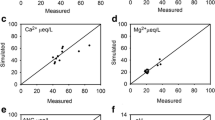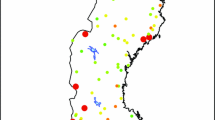Abstract
Many lakes in the Adirondack Mountains, New York, have acidified over the past century due to acidic atmospheric deposition. More recently, most monitored lakes have shown signs of chemical recovery (increase in acid neutralizing capacity) as sulfur deposition levels have declined in response to the Clean Air Act and other emissions control legislation. We used measured and modeled trends in past lakewater acidification and projections of future recovery from acidification to extrapolate results from judgment samples of intensively studied lakes to the population of acid-sensitive Adirondack lakes. Simulations were developed for 70 watersheds using the Model of Acidification of Groundwater in Catchments (MAGIC) to classify lakes according to their sensitivity to change in atmospheric S and N deposition. MAGIC simulations suggested that the modeled Adirondack Long-Term Monitoring Project (ALTM) and Adirondack Effects Assessment Project (AEAP) lakes were largely among the lakes in the population that had acidified most between 1850 and 1990. Most of the modeled ALTM/AEAP lakes were within the top 36% of acid sensitivity, based on model projections of past acidification and future chemical recovery, compared with the 1,829 Adirondack lakes in EPA’s Environmental Monitoring and Assessment Program (EMAP) statistical frame. Results of this research will allow fuller utilization of data from on-going chemical and biological monitoring and process-level studies by providing a basis for regionalization of findings and developing/refining relationships among watershed characteristics, chemical change, and biological responses to changing levels of acidic deposition.





Similar content being viewed by others
References
Baker, J. P., Gherini, S. A., Christensen, S. W., Driscoll, C. T., Gallagher, J., Munson, R. K., et al. (1990). Adirondack lakes survey: An interpretive analysis of fish communities and water chemistry, 1984–1987. Ray Brook, NY: Adirondack Lakes Survey.
Blume, L., Schumacher, B., Schaffer, P., Cappo, K., Papp, M., Van Remortel, R., et al. (1990). Handbook of methods for acid deposition studies laboratory analyses for soil chemistry. EPA/600/4-90/023. Las Vegas, NV: US EPA.
Burnham, K. P., & Anderson, D. R. (1998). Model selection and inference, A practical information-theoretic approach. New York: Springer.
Charles, D. F. (Ed.) (1991). Acidic deposition and aquatic ecosystems: Regional case studies. New York: Springer.
Chen, L., & Driscoll, C. T. (2004). An evaluation of processes regulating spatial and temporal patterns in lake sulfate in the Adirondack region of New York. Global Biogeochemical Cycles, 18, GB3024, doi:10.1029/2003GB002169.
Cosby, B. J., Wright, R. F., Hornberger, G. M., & Galloway, J. N. (1985). Modelling the effects of acid deposition: Assessment of a lumped parameter model of soil water and streamwater chemistry. Water Resources Research, 21, 51–63.
Downing C. E. H., Vincent, K. J., Campbell, G. W., Fowler, D., & Smith, R. I. (1995). Trends in wet and dry deposition of sulfur in the United Kingdom. Water Air and Soil Pollution, 85, 659–664.
Driscoll, C. T., Driscoll, K. M., Roy, K. M., & Mitchell, M. J. (2003). Chemical response of lakes in the Adirondack region of New York to declines in acidic deposition. Environmental Science and Technology, 37, 2036–2042.
Fernandez, I. J., Rustad, L. E., Norton, S. A., Kahl, J. S., & Cosby, B. J. (2003). Experimental acidification causes soil base cation depletion in a New England forested watershed. Soil Science Society of American Journal, 67, 1909–1919.
Hornberger, G. M., Cosby, B. J., & Wright, R. F. (1989). Historical reconstructions and future forecasts of regional surface water acidification in southernmost Norway. Water Resources Research, 25, 2009–2018.
Jassby, A. D. (1998). Interannual variability at three inland water sites: Implications for sentinel ecosystems. Ecological Applications, 8(2), 277–287.
Jenkins, A., Cosby, B. J., Ferrier, R. C., Walker, T. A. B., & Miller, J. D. (1990). Modelling stream acidification in afforested catchments: An assessment of the relative effects of acid deposition and afforestation. Journal of Hydrology, 120, 163–181.
Kretser, W., Gallagher, J., & Nicolette, J. (1989). An evaluation of fish communities and water chemistry. Ray Brook, NY: Adirondack Lakes Survey.
Landers, D. H., Overton, W. S., Linthurst, R. A., & Brakke, D. F. (1988). Eastern lake survey: Regional estimates of lake chemistry. Environmental Science and Technology, 22, 128–135.
Larsen, D. P., Thornton, K. W., Urquhart, N. S., & Paulsen, S. G. (1994). The role of sample surveys for monitoring the condition of the nation’s lakes. Environmental Monitoring and Assessment, 32, 101–134.
Mollitor, A. V., & Raynal, D. J. (1982). Acid deposition and ionic movements in Adirondack forest soils. Soil Science Society of American Journal, 46, 137–141.
Newton, R. M., & Driscoll, C. T. (1990). Classification of ALSC lakes. In Adirondack lakes survey: An interpretive analysis of fish communities and water chemistry, 1984–1987 (pp. 2–91). Ray Brook, NY: Adirondack Lakes Survey.
Ollinger, S. V., Aber, J. D., Lovett, G. M., Millham, S. E., Lathrop, R. G., & Ellis, J. M. (1993). A spatial model of atmospheric deposition for the northeastern U. S. Ecological Applications, 3, 459–472.
Paulsen, S. G., Hughes, R. M., & Larsen, D. P. (1998). Critical elements in describing and understanding our nation’s aquatic resources. Journal of the American Water Resources Association, 34, 995–1005.
Stoddard, J. L., Driscoll, C. T., Kahl, J. S., & Kellogg, J. H. (1998). Can site-specific trends be extrapolated to a region? An acidification example for the Northeast. Ecological Applications, 8(2), 288–299.
Stoddard, J. L., Kahl, J. S., Deviney, F. A., DeWalle, D. R., Driscoll, C. T., Herlihy, A. T., et al. (2003). Response of surface water chemistry to the Clean Air Act Amendments of 1990. EPA 620/R-03/001. Research Triangle Park, NC: US Environmental Protection Agency, Office of Research and Development.
Stoddard, J. L., Newell, A. D., Urquhart, N. S., & Kugler, D. (1996). The TIME project design. II. Detection of regional acidification trends. Water Resources Research, 32, 2529–2538.
Sullivan, T. J., Cosby, B. J., Herlihy, A. T., Webb, J. R., Bulger, A. J., Snyder, K. U., et al. (2004). Regional model projections of future effects of sulfur and nitrogen deposition on streams in the Southern Appalachian Mountains. Water Resources Research, 40(2), W02101 doi:10.1029/2003WR001998.
Sullivan, T. J., Fernandez, I. J., Herlihy, A. T., Driscoll, C. T., McDonnell, T. C., Nowicki, N. A., et al. (2006). Acid-base characteristics of soils in the Adirondack Mountains, New York. Soil Science Society of America Journal, 70, 141–152.
US EPA (2004). Technical support document for the interstate air quality rule air quality modeling analysis. Research Triangle Park, NC: US EPA Office of Air Quality Planning and Standards, Emissions Analysis and Monitoring Division.
Whittier, T. R., Paulsen, S. G., Larsen, D. P., Peterson, S. A., Herlihy, A. T., & Kaufmann, P. R. (2002). Indicators of ecological stress and their extent in the population of northeastern lakes: A regional-scale assessment. Bioscience, 52, 235–247.
Acknowledgements
This research was supported by a contract to E&S Environmental Chemistry, Inc. from the New York State Energy Research and Development Authority, through the Environmental Monitoring, Evaluation, and Protection (EMEP) Program. We thank Mark Watson for his assistance. The Adirondack Effects Assessment Program is supported by a grant from the US Environmental Protection Agency (contract number 68D20171) to S. Nierzwicki-Bauer and C. Boylen at Rensselaer Polytechnic Institute. Although this portion of the work was funded by the US Environmental Protection Agency, it has not been subjected to the Agency’s review and, therefore, does not necessarily reflect the views of the Agency, and no official endorsement should be inferred.
Author information
Authors and Affiliations
Corresponding author
Rights and permissions
About this article
Cite this article
Sullivan, T.J., Cosby, B.J., Herlihy, A.T. et al. Assessment of the Extent to Which Intensively-studied Lakes are Representative of the Adirondack Region and Response to Future Changes in Acidic Deposition. Water Air Soil Pollut 185, 279–291 (2007). https://doi.org/10.1007/s11270-007-9449-2
Received:
Accepted:
Published:
Issue Date:
DOI: https://doi.org/10.1007/s11270-007-9449-2




